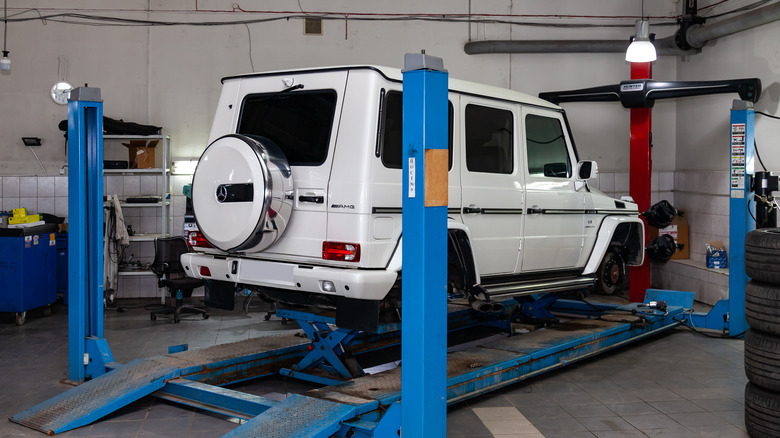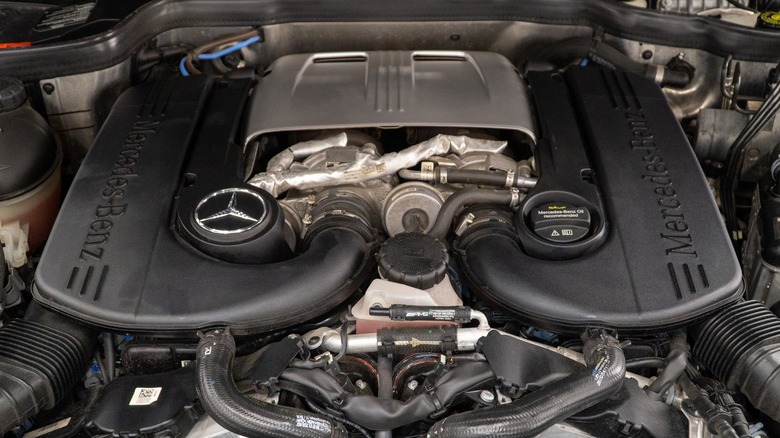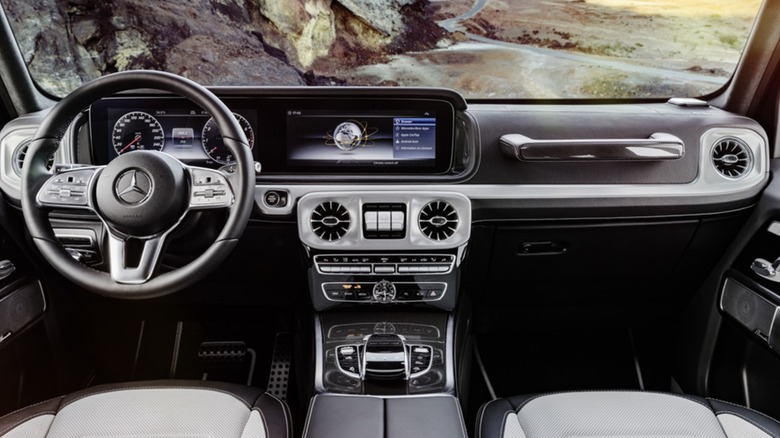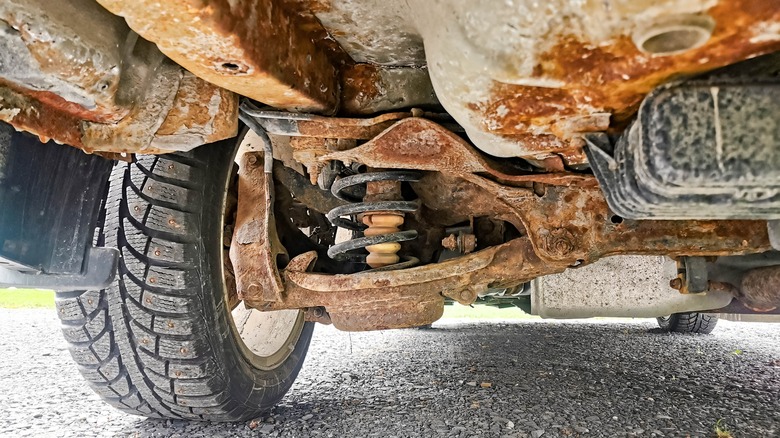10 Things To Consider When Buying A Used Mercedes G-Wagon
So, you've decided a used G-wagon is calling your name. Totally understandable — few vehicles combine rugged capability, luxury, and status quite like Mercedes' boxy off-roader. It's one of those rides that makes a statement wherever it goes. The best part? You don't need to drop $140,000 for a base model G-Wagon (or a truly eye-watering $200,000 for a fully loaded AMG) to get the full G experience. A well-chosen used model can save you $50,000 or more while delivering the same thrill.
However, these aren't your average SUVs. A G-wagon is a German engineering masterpiece, which means when it's good, it's legendary, and when it's bad, it's a wallet-melting nightmare. These trucks have stories, ranging from glamorous celebrity-owned pasts to sketchy off-road abuse and little to no maintenance. Your mission? Make sure you're inheriting the right kind of history.
Fortunately, this guide is here to help. To avoid ending up with a $100,000 project car, here are the 10 make-or-break things you must check before buying a used G-wagon.
Which used G-Wagon model year is right for you?
Not all Mercedes G-Wagon generations are created equal. Sure, they all rock that boxy, tough-as-nails look and come with multiple locking differentials, but over the years, Mercedes kept tweaking the formula. If you're the type who unironically says, "They don't make 'em like they used to," the '80s and early '90s models will speak to your soul. These are the G-Wagons with vinyl seats, manual windows, and a ride quality that lets you feel every pebble in the road, which makes them perfect for off-roading.
So what if you want a G-Wagon that still feels tough, just without sacrificing things like climate control and a little peace and quiet on the highway? That's where the late '90s and 2000s models come in. These trucks got plusher interiors, actual sound insulation, and the first AMG variants if you wanted your off-roader to also outrun sports cars. Then, there's the 2012 to 2018 crowd — the Goldilocks zone of used G-Wagons. Modernish tech meets boxy charm, with bi-turbo V8 and V12 AMG versions that'll pin you to your seat.
What if money's no object? The 2019 and up models are basically G-Wagons in name only. They have the same iconic shape with a twin-turbo heart that now comes standard, an S-Class worthy cockpit, and a suspension tuned for comfort. They're incredible, but you'll pay for it, and these things depreciate like a brick — a very expensive, very fast brick.
Are you buying for enjoyment or future collector appeal?
Most people don't buy a G-Wagon purely for practicality. You're either in it for the thrill of driving an absolute unit of a vehicle, or you're playing the long game, hoping your purchase turns into a six-figure collectable down the road.
If you're all about the driving experience, you've got options. The standard G550 is plenty capable (and still turns heads), but why stop there? AMG models like the G63 crank up the insanity with 577 horsepower, 627 lb-ft of torque, and a nine-speed automatic gearbox putting all that power to the ground. Then there are the aftermarket tuners, like Brabus, Carlsson, Lorinser, and RENNtech, who take an already wild machine and dial it up to 11.
However, maybe you're thinking like an investor. In that case, special editions are where the money's at. Limited-run AMGs, like the six-wheeled G63 6x6 or the G650 Landaulet, are already fetching stupid money on the collector market. Also, don't forget the Puch-built G-Wagons, like the 1993 500 GE. There's a catch, though — these rare collector gems often sit in climate-controlled garages, barely driven, because every mile chips away at their value. In the end, you have to decide if you want to chase thrills now or returns later.
What secrets hide in the maintenance records?
Think of a G-Wagon's maintenance records as its automotive diary. They're a window into the vehicle's past, potentially revealing dark secrets that could save you from a costly headache. When you're considering a used G-Wagon, seeing these records for yourself is a must.
Start by scanning for signs of neglect. For pre-2018 models, oil changes should appear like clockwork every 5,000 to 7,500 miles. The newer models can stretch to 10,000-mile intervals, but only with proper synthetic oil. Other routine maintenance like brake fluid flushes, spark plug swaps, and transmission and filter changes should all follow Mercedes' recommendations for that year and trim. If those basics were skipped, what else might've been?
Then, take note of any major repairs. Rebuilt transmissions, turbo replacements, or full suspension overhauls are all worth a closer look. Big-ticket fixes like these can hint at how the vehicle's been driven, like whether it's been gently cruised or pushed to its limits. A major repair isn't always a red flag, but it's your cue to ask more questions.
Ideally, you want to see a folder full of full dealer receipts for maintenance and repairs. But a well-documented service history from a reputable Mercedes indie shop works, too. If the records are just scribbles on napkins? Hard pass. No paperwork at all? Assume the worst and keep shopping.
Is that signature G-Wagon power still flowing smoothly?
A well-cared-for G-Wagon should fire up with authority, not whimper to life like a tired sedan. You want to make sure it's still got that "Oh dang, this thing means business" energy. You do that by hearing the first morning startup. If the seller won't let you be the one to wake it up, that's your first red flag waving furiously.
Begin checking the engine over by pulling the dipstick to confirm the oil is amber (not black) and at the right level. Peek at the coolant tank, too. If it's low or murky, that engine's been running hot. Now proceed to your cold start test — the engine should roar to life with a deep, confident growl, especially if it's an AMG model. If it sounds like it's struggling to idle smoothly, walk away.
Once you're on the road, put your ears to work. Ticking or knocking noises could be expensive valve train or timing chain issues. A whining sound when you accelerate might be turbo or transmission trouble brewing. Something is definitely off if the legendary exhaust notes sound anything but clean and muscular.
When you come back from the test drive, park over clean pavement to check for leaks — the classic German car special. A few minor oil spots might be normal on higher-mileage examples, but fresh coolant or mysterious rainbow-colored puddles are deal breakers.
Are all the tech features working like they should?
Don't let the tough exterior fool you — a G-Wagon is loaded with tech. Unless you're going way back to the early years, you'll find features like rain-sensing wipers, heated power seats, and a 6.5-inch high-res screen running the COMAND system. Of course, those premium features don't mean much if they've stopped doing their job.
So before you sign any paperwork, play detective with all the buttons and screens. Start with the cozy stuff. Are those heated seats actually toasty? Does the AC blow cold when it should? Push every button, twist every knob, and make sure it all does what it's supposed to. You don't want to find out the A/C or heat is busted when the weather decides to go extreme.
Then, the fun stuff. Try out the infotainment system. Does the touchscreen react as fast as a brand-new phone, or does it have some lag to it? Can you blast your favorite tunes without any speaker crackle? Does the GPS actually know where you are? Test it all because a wonky infotainment system can turn an exciting road trip into a real nightmare.
Remember to check the little things, too. Do the windows go up and down smoothly? Do the mirrors adjust like they should? Are all the lights working? Even a tiny light bulb issue can point to bigger electrical gremlins.
Have you looked in all the places where G-Wagons typically rust?
Even the mighty G-Wagon isn't immune to rust, and you definitely don't want to discover it after you've already signed the papers. These trucks are built tough, but time, weather, and road salt do their thing. Luckily for you, it's easy to spot corrosion issues if you know where to look.
First stop: the undercarriage. A little surface rust is normal for a truck that's actually been driven, but if you see flaking areas or holes, that's your cue to walk away fast — or maybe even consider some Mercedes G-Wagon alternatives. Pay special attention to the frame rails where they curve up near the wheels, as these like to rot from the inside out.
Now, run your fingers along the windshield frame under the rubber seals. Surprise! If your fingers come away orange, you've just found the most expensive windshield replacement of your life. The door sills are next. Peel back those rubber seals a tiny bit and look for bubbling paint. Look at the door hinges, too. Finally, check the rear wheel arches, where mud and salt love to hide. If it looks like someone went at them with a cheese grater, those repair bills will hurt.
Are there any battle scars from off-road use?
The G in G-Wagon stands for Geländewagen – German for cross-country vehicle — and these trucks were built to conquer brutal terrain. That means the used model you're eyeing might've lived a very interesting life. Get down and dirty underneath to inspect the evidence.
Skid plates should show protective wear, not deep gouges from losing fights with boulders. Fresh scrapes on the differential housings? That's the calling card of an owner who actually used their G properly — or abused it terribly. The suspension can also reveal a lot about a G-Wagon's past adventures. Inspect the shocks for leaking fluid or dents. Check the condition of the control arms and bushings. If you see shiny new bolts in ancient control arms, that's a red flag for crash damage repairs.
Go beyond an inspection with a quick test. Find some loose gravel and engage all three differential locks — center, rear, then front. Each should click into place within seconds. Any hesitation, grinding noises, or blinking dash lights suggest expensive repairs are in your future. If the seller proudly shows off their mud-caked undercarriage but claims they've "never used the diff locks," that's usually code for "they're seized from neglect."
Will previous accident repairs come back to haunt you?
A clean CarFax doesn't guarantee a clean history, though it doesn't hurt to check, of course. The truth is that these vehicles are often too expensive to total, meaning a used G-Wagon could just get stitched back together and resold with a minor accident report instead.
So, how do you tell if a car's been in an accident? By playing panel gap police, for starters. Mercedes built these vehicles with precision German engineering, and uneven spacing between body panels is a telltale sign of repair work. If the doors don't close with their signature thunk or the hood sits slightly cockeyed, alarm bells should ring.
After that, inspect the paintwork. Factory luxury car finishes are typically flawless, so if you spot orange peel texture, overspray on rubber seals, or color mismatches between panels, someone's been doing budget bodywork. The seller's reaction speaks volumes, too. If they suddenly develop a nervous twitch when you're inspecting the radiator support, it might be time to check out someone else's G-Wagon.
If you suspect tomfoolery, talk to your local Mercedes dealer. They can often pull hidden records, like dealer repairs and warranty work, that never made it to CarFax.
Are you ready for the cost of owning a used G-Wagon?
Owning a G-Wagon is like adopting a very fancy, expensive pet. Sure, you're buying it used, but this isn't some economy SUV where you can skimp on oil changes and call it a day. The second that three-pointed star is in your driveway, your wallet is officially on notice.
First, let's get maintenance out of the way. Even a used G-Wagon expects to be treated like royalty at the dealership. According to Edmunds' analysis of a 2020 AMG G-Wagon, you're looking at roughly $1,500 annually just for routine care. Need basic repairs? Expect to add another $1,600 to $4,000 to the bill each year.
Then there's insurance. Insurers see "Mercedes," "off-road capable," and "expensive to fix" and immediately assume you're a big risk to their pocketbooks. For that, you'll pay at least $1,400 annually, depending on your age, location, and how many times you've been caught speeding.
Finally, the elephant in the room — fuel. This brick-on-wheels guzzles premium gas to the tune of 13 to 15 MPG on a good day. So, what's all that fuel going to cost you? Likely around about $5,000 annually for around 15,000 miles. Think those maintenance, insurance, and fuel bills are bad? Buckle up. After calculating financing, taxes, fees, and depreciation, Edmunds estimates the true cost to own at nearly $150,000. Consider it a luxury tax on awesomeness.
Will your G-Wagon depreciate like a rock or hold steady?
Depreciation is the silent money thief that eats away at your vehicle's value each year. You may not think about it much, but when it comes time to sell your used G-Wagon, that depreciation becomes very real. So, the big question is — will your boxy beauty hold its value, or will it plummet like a rock?
The cold, hard truth? The new 2025 G 550 will lose about half its value after five years, according to CarEdge. Ouch, but before you panic, consider this — that's actually better than nearly every other luxury SUV out there. Your neighbor's Range Rover? It's depreciating like a sinking ship compared to your G-Wagon, with CarEdge estimating that it will lose three-fourths of its value in the same amount of time.
Thankfully, all is not lost. If you've got something truly special, like a limited-edition Brabus G-Wagon, then you're undoubtedly in the money. Otherwise, don't kid yourself. This is a luxury toy, not an investment. Now go enjoy that V8 roar, and try not to think about the numbers too much.
Is a used G-Wagon worth it?
You've done your homework, so let's cut to the chase. A used G-Wagon is a lifestyle subscription with unpredictable monthly fees that are potentially well beyond the initial purchase price. The savvy buyer — that's you — understands that these machines exist in a financial twilight zone between money pit and rolling flex.
When you find the right one, something magical happens. The repair bills hurt less. The fuel stops feel intentional. And every time you turn the key, the guttural startup roar makes everything else fade away. Does that make a used G-Wagon worth it? Only you can decide.
If you do decide to gift yourself the full G-Wagon experience, promise the world one thing — you'll take it off-road at least once. After all, that's what it was born to do, even if it does look awfully good in the valet line.











